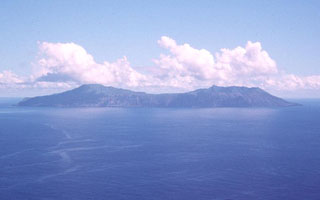Report on Anatahan (United States) — 24 May-30 May 2006
Smithsonian Institution / US Geological Survey
Weekly Volcanic Activity Report, 24 May-30 May 2006
Managing Editor: Sally Sennert.
Please cite this report as:
Global Volcanism Program, 2006. Report on Anatahan (United States) (Sennert, S, ed.). Weekly Volcanic Activity Report, 24 May-30 May 2006. Smithsonian Institution and US Geological Survey.
Anatahan
United States
16.35°N, 145.67°E; summit elev. 790 m
All times are local (unless otherwise noted)
Based on a pilot report, the Washington VAAC reported that an ash plume from Anatahan reached an altitude of 3 km (10,000 ft) a.s.l. on 29 May and drifted W. Emissions from the E crater of vog (volcanic fog), steam, and a gas plume were visible on satellite imagery at about 1333 and increased prior to generation of the ash plume. A report issued from the Washington VAAC on 30 May at 0535 indicated a faint, low-level gas-and-ash plume extending from the summit.
Geological Summary. The elongate, 9-km-long island of Anatahan in the central Mariana Islands consists of a large stratovolcano with a 2.3 x 5 km compound summit caldera. The larger western portion of the caldera is 2.3 x 3 km wide, and its western rim forms the island's high point. Ponded lava flows overlain by pyroclastic deposits fill the floor of the western caldera, whose SW side is cut by a fresh-looking smaller crater. The 2-km-wide eastern portion of the caldera contained a steep-walled inner crater whose floor prior to the 2003 eruption was only 68 m above sea level. A submarine cone, named NE Anatahan, rises to within 460 m of the sea surface on the NE flank, and numerous other submarine vents are found on the NE-to-SE flanks. Sparseness of vegetation on the most recent lava flows had indicated that they were of Holocene age, but the first historical eruption did not occur until May 2003, when a large explosive eruption took place forming a new crater inside the eastern caldera.
Sources: Emergency Management Office of the Commonwealth of the Mariana Islands and United States Geological Survey Volcano Hazards Program, Washington Volcanic Ash Advisory Center (VAAC)

